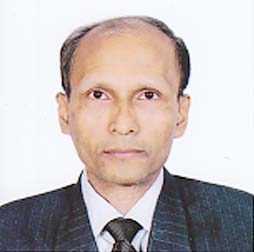
Masum Billah :
Very recently I have seen news in a national daily that a government primary school at Dumuria Upazila, Khulna runs with an abnormaility. Usually, schools start in the morning with morning assembly where students chant national anthem and enter the classroom being in line. After entering the classroom roll call takes place and then teaching starts. After the break up the school hears a buzzing sound of the students who quickly run out of the classroom talking, laughing and gossiping. The entire campus becomes a buzzing place. However, this school sees only one student who studies in class two; hence no such activities take place here. The school does not seem to have any lively situation. Three teachers of the school teach this only one student. The school was established in 1991 and got nationalised in 2013.
Moynapur village accommodates the school which remains surrouned by water and no children were born in the last four to five years who can be eligible for going to primary school. Moreover, the introduction of ‘catchment area’ in 2016 that talks about admission to schools in the respective areas of students that debarred the guardians to send their children to this school. The primary education officer of this upazila comments in this way’ in my life I have never seen that a school is run with only one student. It’s true that the area is hard to reach and remote but a road has been made to connect this area with adjacent localities. Still pupils are not coming to the school. It stands at the end of Dumuira bordering Keshabpur upazila under Jashore district. A proposal has been sent to the authorities to close the school and transfer the teachers to Keahspur. No reply has yet been received. However, if it happens the nearby primary school will be two kilomertresaway from the current site of the school that may cause problems for the children of future days.
Chatardighi Government Primary School under Raninagar Upazila of Naogaon District is running with 14 students only. Here class four sees only one student and there is no student in class five. There are five teachers but remain present only three. The local people say that the conflct between the acting headteacher and school managing committee is responsible for poor number of students in the school and the number is going to be zero gradually. The school stands 18 kilometers away from Upazila Sadar. Recently a new building has been built at a cost of Tk 60 lac 62 thousand. The headteacher says that they have been trying to collect students through visitng from home to home, still no positive result accrues. Of course, the school shows 55 students in their official documents. Some local people say teachers don’t show their dedication to the profession that causes the pupils to go to other schools.
This is the picture of our government primary schools and another picture in terms its quality we see a miserable picture. BRAC Institute of Education conducted two researches to learn the rate of students going backward in education due to Corona. It shows that in 2016 the literacy skill among the students of grade five was 31.4 per cent that was supposed to become 34.5 per cent in 2021. But surprisingly, it has become 27.2 per cent instead. The researchers express that the students who can read, write and identify and apply numbers were considered for the reseach. Their rate has decreased by 7 per cent in the last five years.
Again, 42 lac 87 thousand 979 students did not come back to school after Corona that accounts for 23.2 per cent students of primary level. Another fact has been revealed that more 33 lac 26 thousand 880 pupils than usual time have been dropped out of education due to Corora and its related causes. The researchers say that the target of SDG by 2030 will not be able to fulfil at any cost if this situation continues. The education rate of 2008 shows the same in 2021 that means we have been back by 13 years. If we want to satisfy the criteria of SDG by 2023, we will have to go forward 21 years in 8 years that calls for taking several mega projects in education. However, taking mega projects only do not necessarilty ensure developing the quality of education and other areas if proper accountability is not maintained, reality is not considered and education friendly environment is not created.
Our primary education is nationalised, compulsory and free; still its miserable condition makes us appalled. In some government primary schools students flood the classes and in some areas quite opposite picture we witness even though school buildings, teachers, playground and other necessary facilities are available. We sometimes come across such kind of contrasting pictures of our primary education in various parts of the country.
We should consider geographical locations, density of population and distance between existing schools while building new schools otherwise education sector will incur loss that we have already seen in some government primary schools.
(Masum Billah is Country Director, Volunteers Association for Bangaldesh and President, English Teachers’ Association of Bangaldesh).

